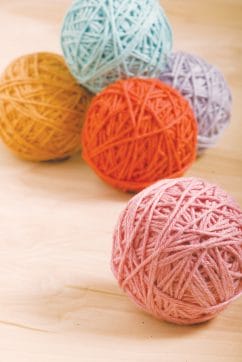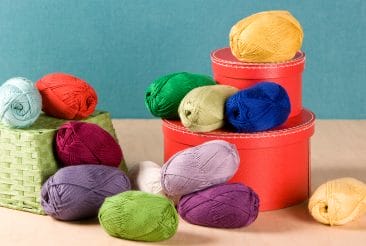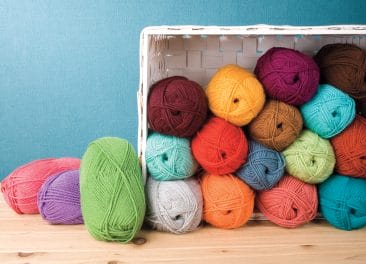No matter how much I love working with wool for my projects, I know that it is not always the most appropriate choice. Whether I am working my way through yarn options for baby items, afghans and throws, or simply a project request from a wool-sensitive friend, I look towards easy care yarns and other non-wool fibers. Now, when you see easy care – it can be tempting to simply toss your finished objects in the washer with the rest of your clothes. Instead, I like to think of these fibers as easier care yarns. Along with a few tips and tricks, you can ensure a long and happy life for your hand knit and crocheted projects made from easy care yarns such as superwash fibers, cotton and cotton blends as well as acrylic yarns.
Swish Tonal Worsted
Superwash yarns are wool fibers that have been treated in a way that makes them less likely to felt in the wash. This usually happens in one of two ways – the wool is treated in a bath that removes the scales of each fiber or the fiber is coated to smooth the scales, which prevents them from clinging together. Superwash yarns, like the Swish yarn family for example, gives you the best of both worlds; you will be able to work with a wool fiber and enjoy the convenience of being able to machine wash your garment. That said, there are a few simple precautions you can take to ensure your garment looks good wash after wash. First, you can place your hand knit or crocheted item in a garment bag. This will help reduce the friction and the general wear and tear of spinning around with your laundry, which will help to reduce pilling. Use the gentle cycle on your washer, or simply make sure that your washer is set to cool water. Some washing machines even have a wool or hand knit cycle setting, which is another option when caring for superwash wool garments. And as for what to do post-wash, the heat of a dryer may still cause some felting to happen, so it is best to lay your garment flat to dry.
Simply Cotton Worsted
Cottons, like our Simply Cotton yarn line, can generally take a little bit more wear and tear than superwash wool yarns, but it is still good to know certain properties that are unique to cotton when planning out your projects. First, cotton is not elastic or bouncy like wool fibers. Second, cotton can tend to get very heavy when wet, which means it is good to take a little extra care to provide support for your knit or crocheted garment after you take it out of the wash. But as I mentioned earlier, it is a fiber than can handle the agitation against other clothes well. This means you can feel free to wash it on either a cool or warm setting, similar to your other cotton shirts and pants. However, depending on the shape, style, and use of your cotton project – you may want to consider steam blocking as well. The inelasticity of cotton combined with the heavy weight when wet may cause items to get stretched out slightly. If your cotton project is a hand towel or dish cloth, this may not be an issue for you and the washing machine option would work fine. You’ll also have the option of tumble drying cottons on a low heat setting in the dryer. But, if you have a fitted project where shape is important, steam blocking might be the way to go.
Comfy Worsted
There are also different types of cotton blend yarns that you may want to experiment with depending on your project choice. Yarns like Comfy, a cotton and acrylic blend, do have the added benefit of elasticity due to the acrylic content. This also helps the longevity of your project as it goes through the washer again and again. But again, as with cottons, Comfy also has a tendency to grow and not come back – so it is best to avoid the dryer and lay it out flat to dry when shape is a concern. Another cotton blend you will find at Knit Picks is CotLin, a blend of cotton and linen. Linen is a fiber that can feel a bit harsh to the touch by itself, but it is also a fiber that actually gets softer after going through a wash cycle. This makes CotLin a wonderful choice when you need a strong and durable fiber that is still soft to the touch.
Brava Worsted
Finally, we have the ultimate in hard wearing and easy care yarns such as Brava, our new 100% premium acrylic yarn! This is truly an easy care yarn, letting you fearlessly create large throws and blankets as well as endless amounts of baby hats and sweaters. Not only will you be able to put your finished object though the wash cycle, but you will be able to have it go into the dryer with the rest of your laundry. The only thing you want to avoid is extreme and direct heat, like steam blocking for example. This is sometimes referred to as “killing” your acrylic because it removes all structure from your yarn and finished object.
And remember, a little extra care can go a long way and your knitted and crocheted projects will love you back even longer. As with all fibers, easy care yarns included, the gentler you can be, the better your projects will look in the long run. When possible, wash your superwash wool, cotton, or acrylic items on the gentle cycle with cool water and minimal agitation. Some of the easy care yarns will last longer if you lay them flat to dry and avoid the dryer all together while other fibers (particularly acrylic) can handle the warm agitation of the dryer cycle.
Even though all of the fibers and blends mentioned above are machine washable, there is definitely a scale of easier care to truly easy care. Knowing the properties of the fibers you are working with and how that translates into the care of the garment is something you will greatly appreciate – especially after the first time you accidently shrink a sweater (and we’ve all been there at one point).
And as always, the best way to avoid the “my sweater now fits my cat” syndrome is to make a swatch! Not only will you be able to see and feel how the fabric drapes or how textures and cables stand out, but you can then take that swatch and care for it as you would your finished object. If you are planning on washing and drying your finished object, do so with your swatch first to see what, if any, properties change. Make sure to take notes and measurements that you can easily refer back to before you wash or block your swatch. That way you can compare and contrast any changes to the swatch with how it looked like before washing or blocking. This way, if anything unexpected comes up – you have only sacrificed a swatch instead of an entire project.
What are some of your favorite tips or tricks to caring for your easy care projects?







